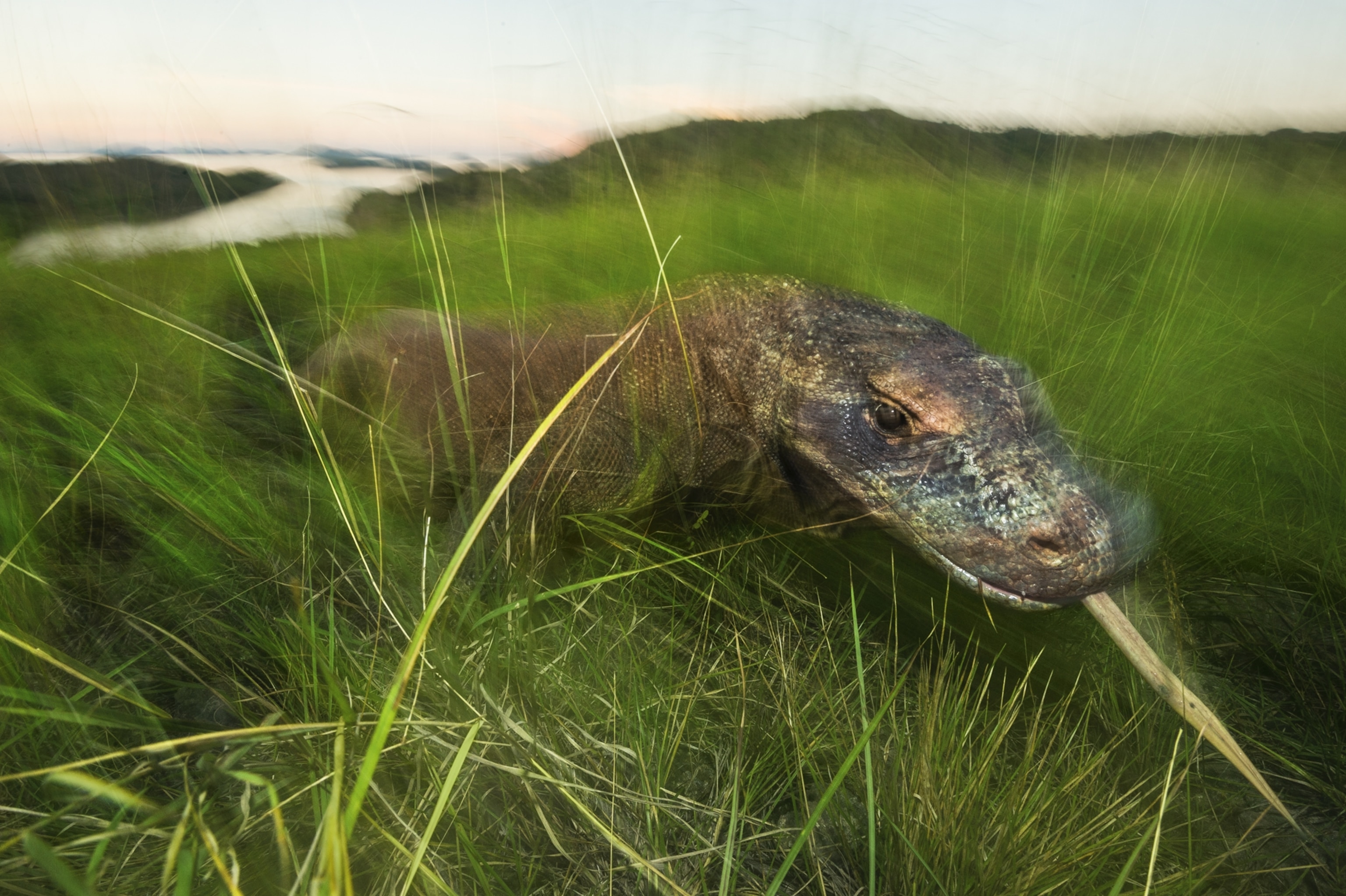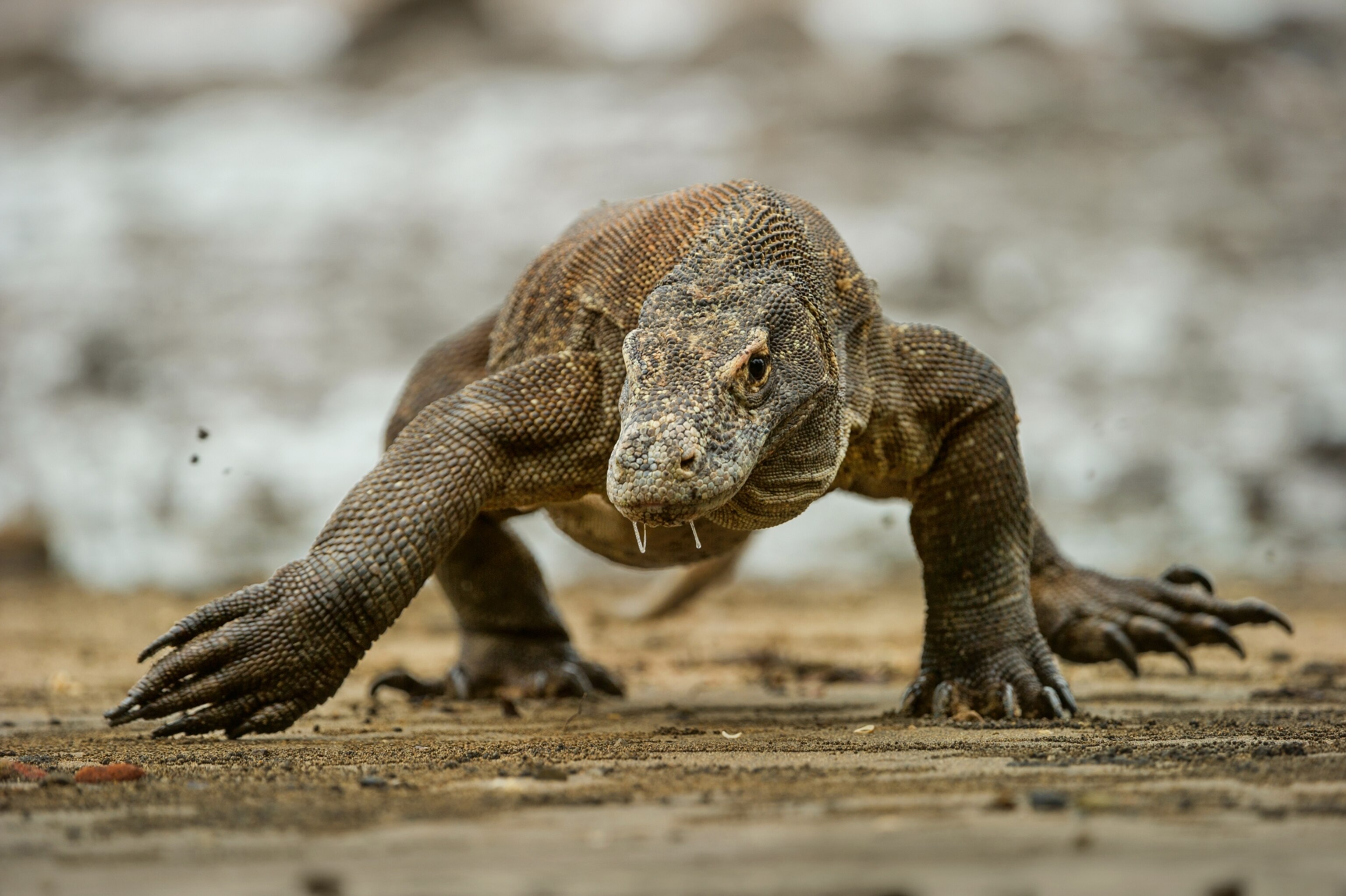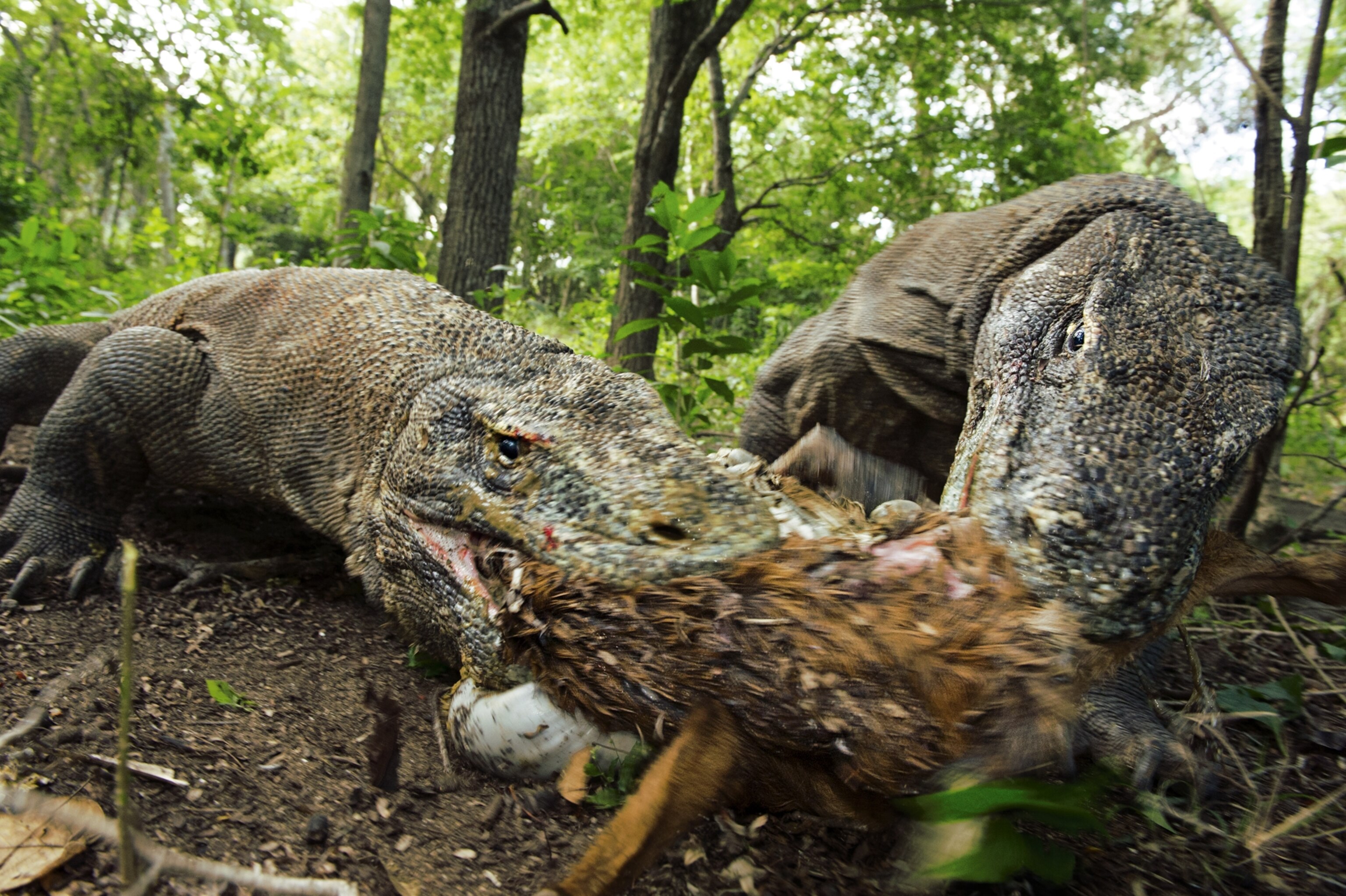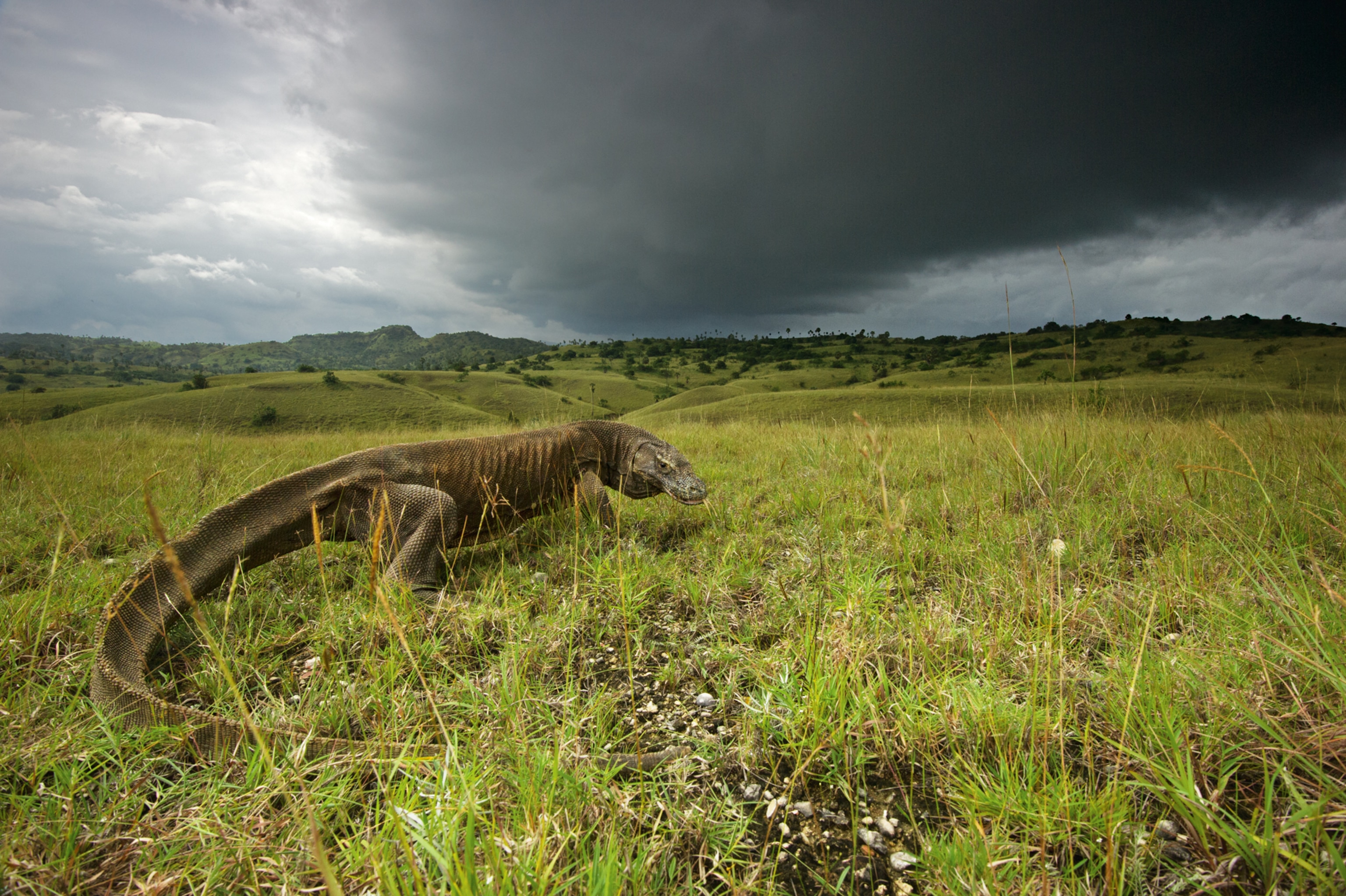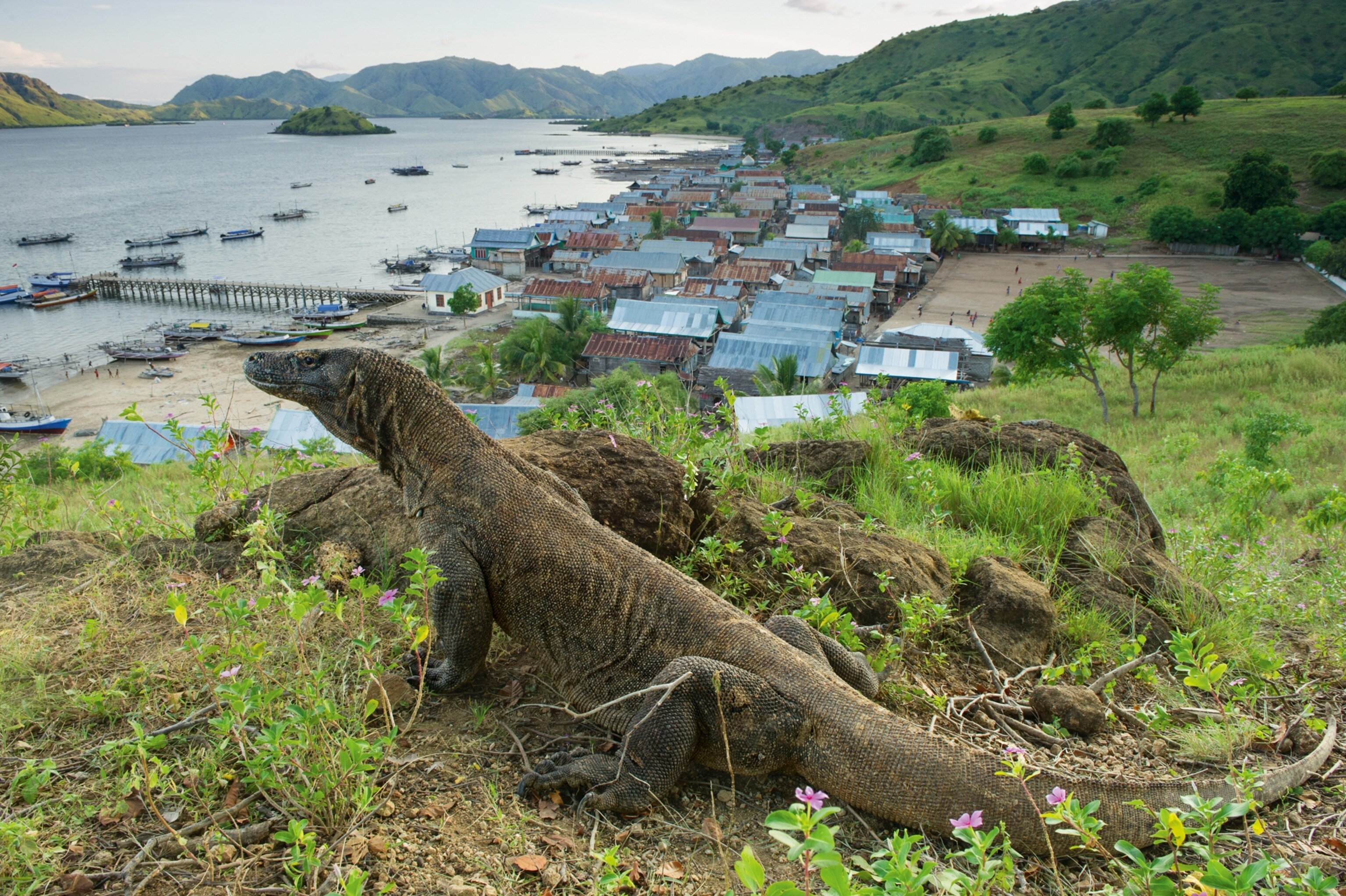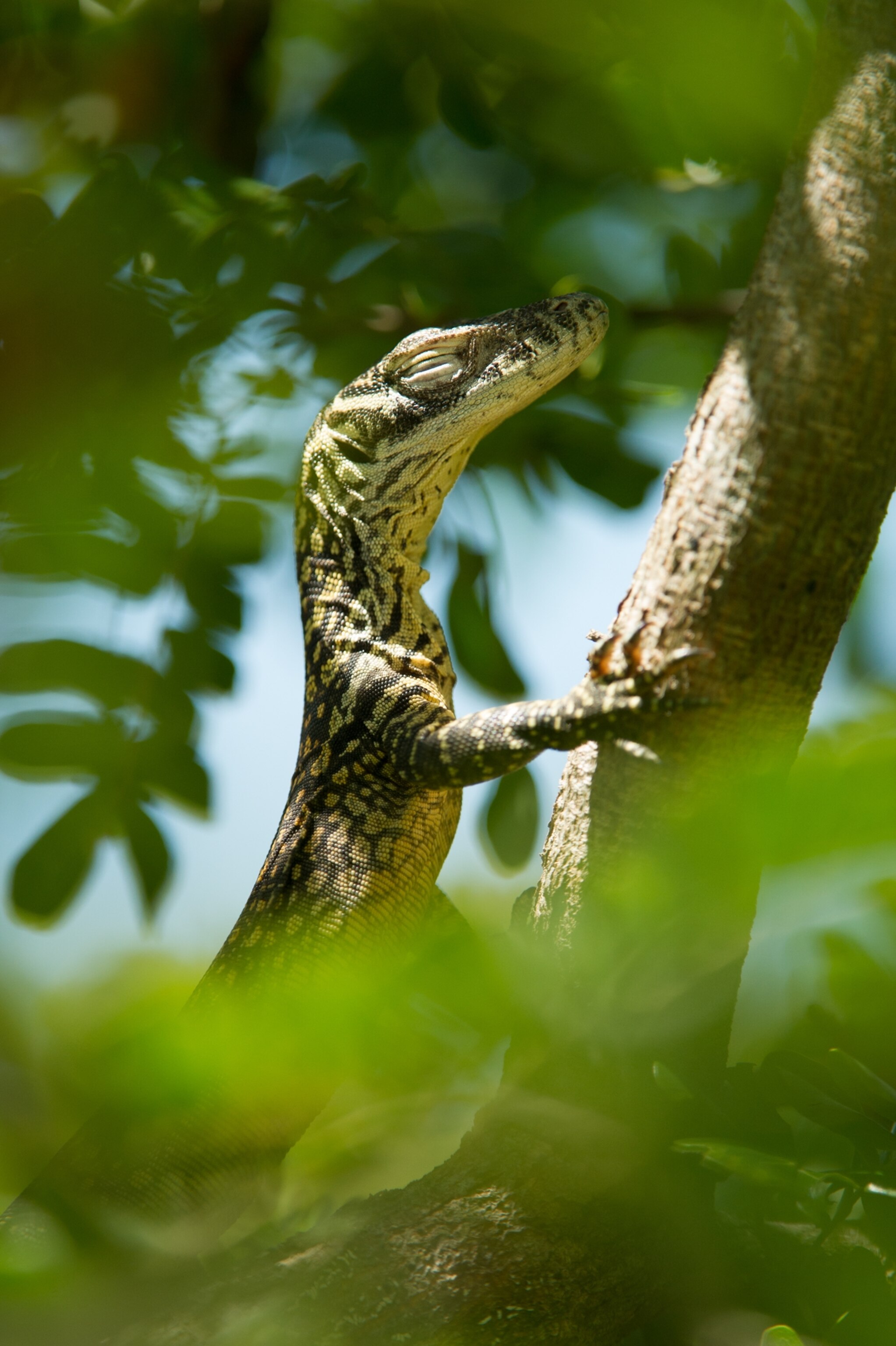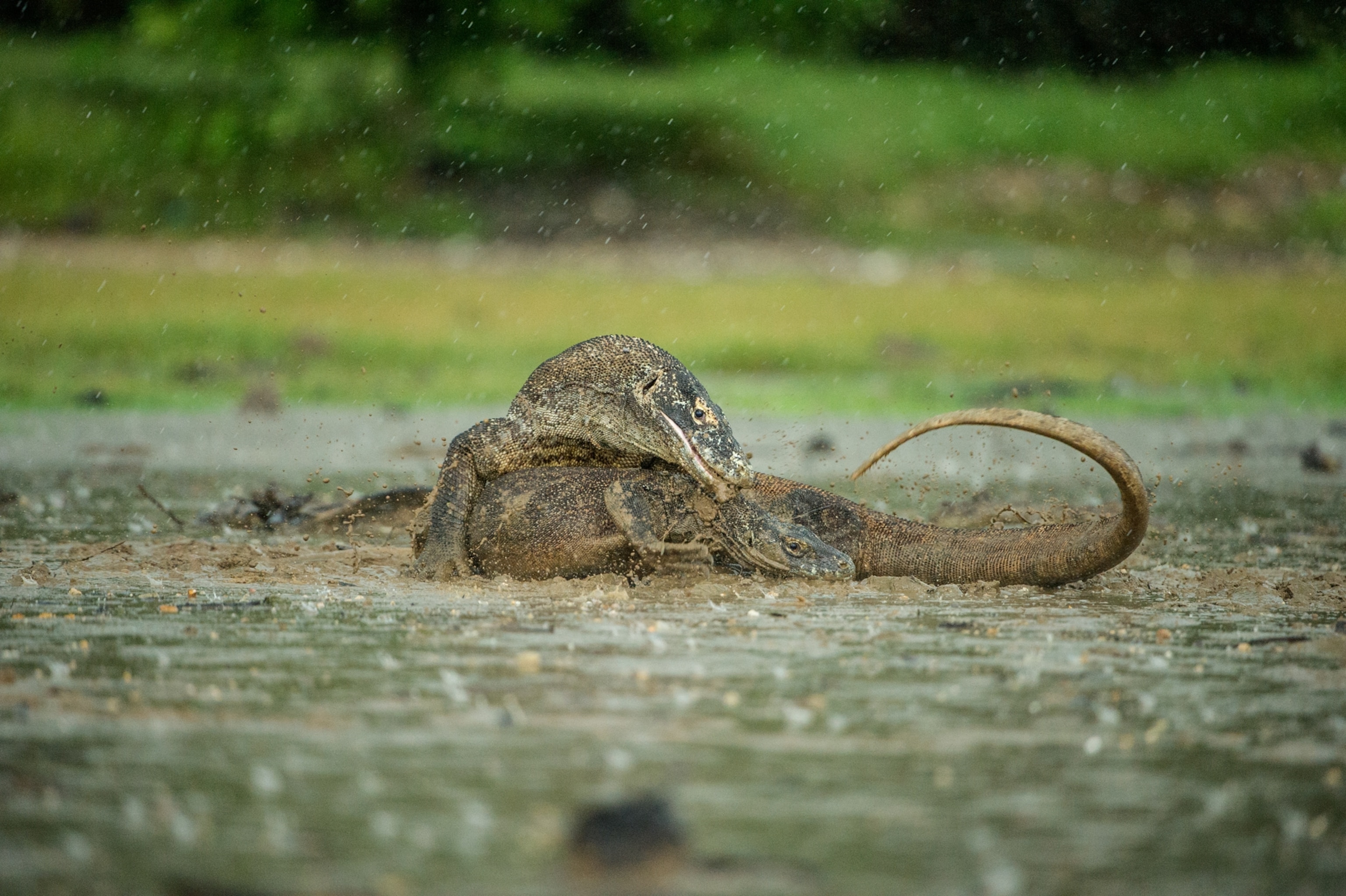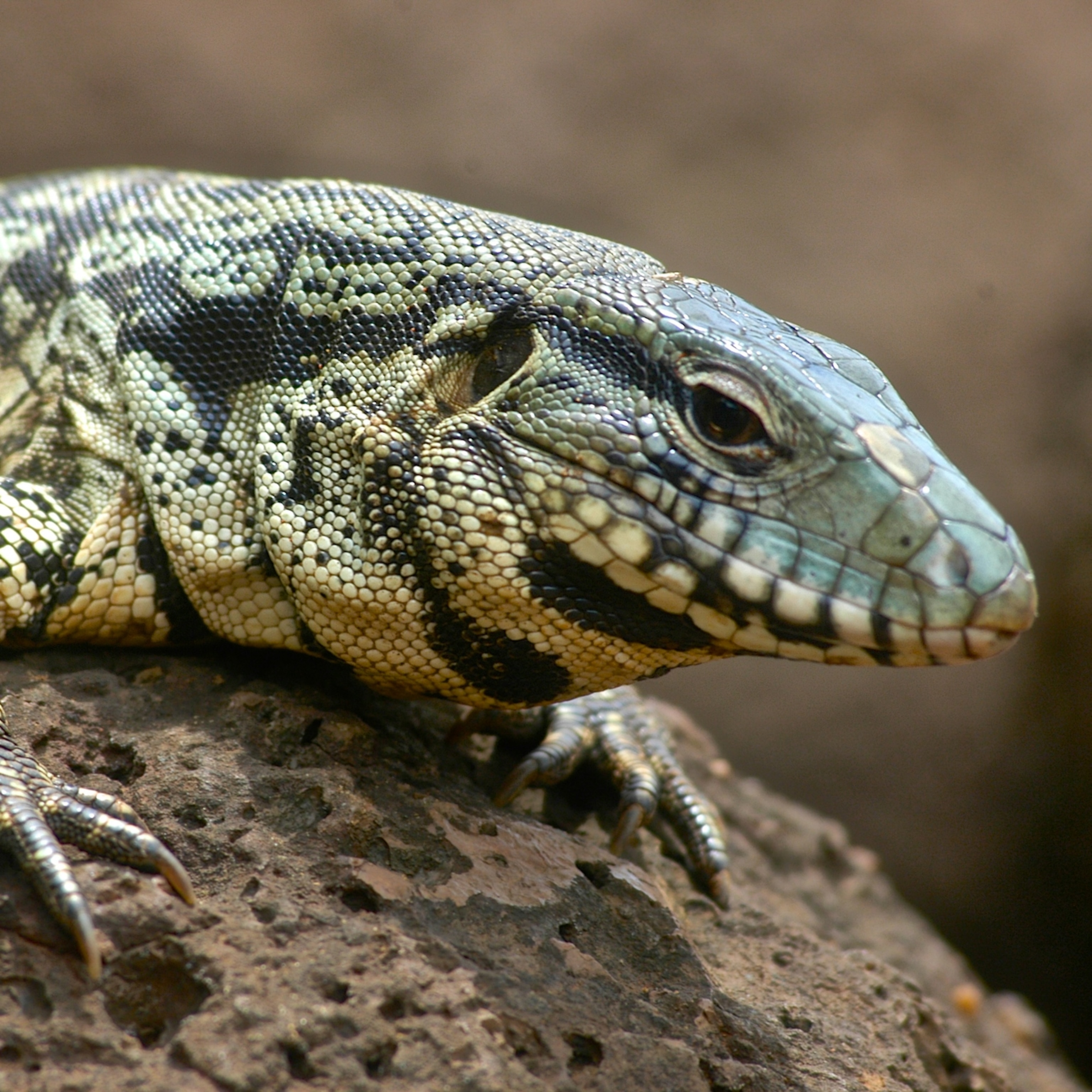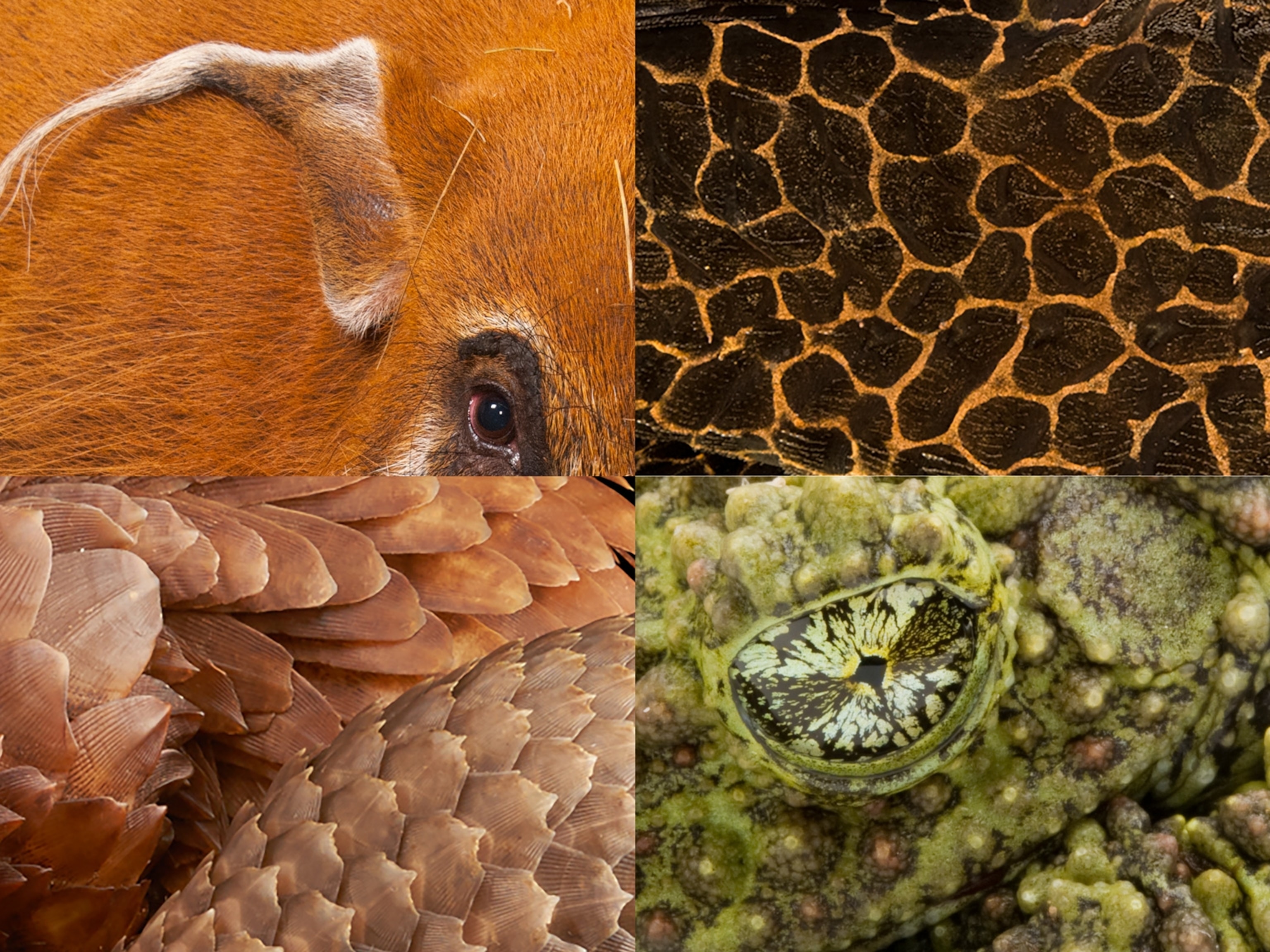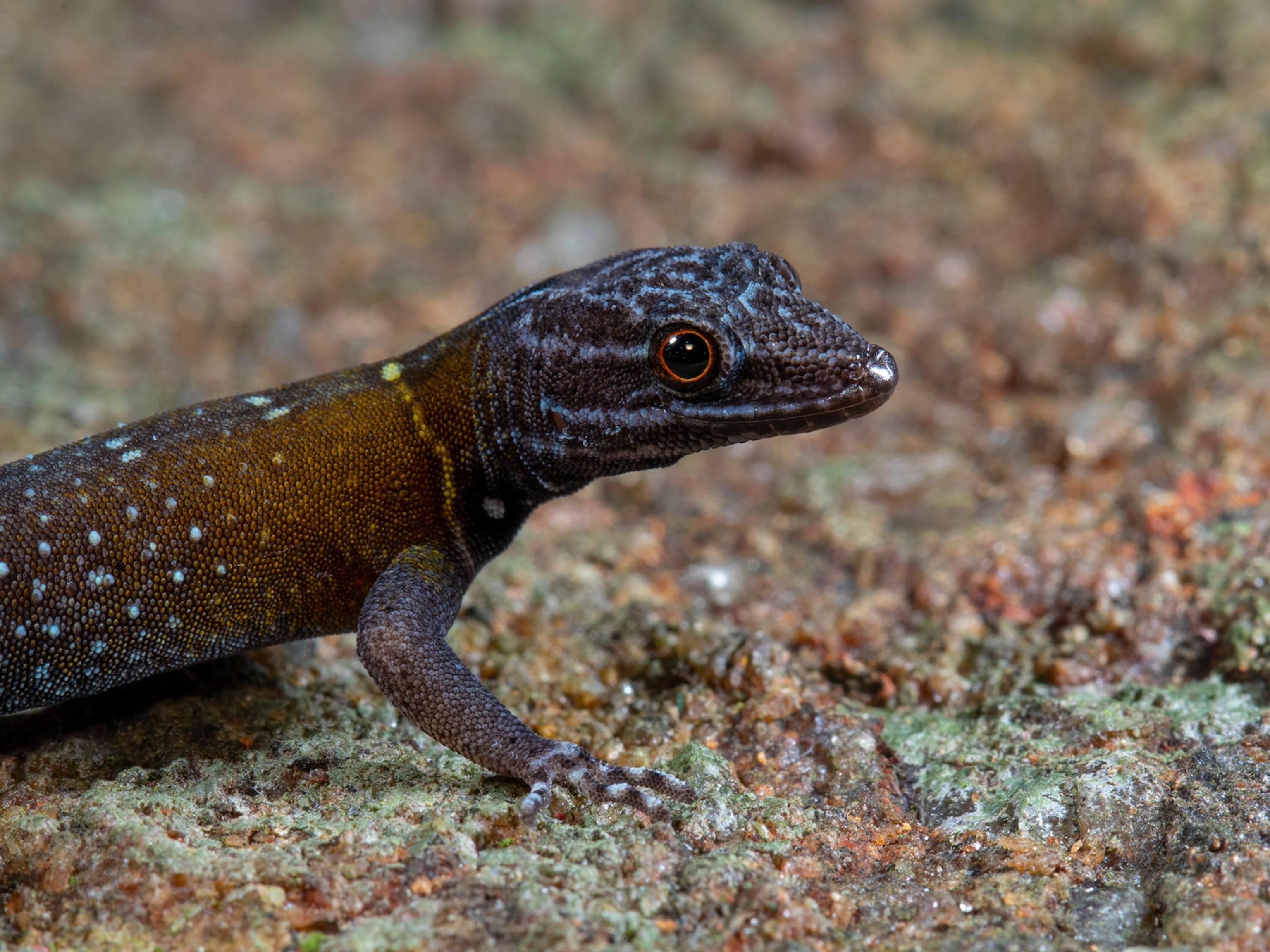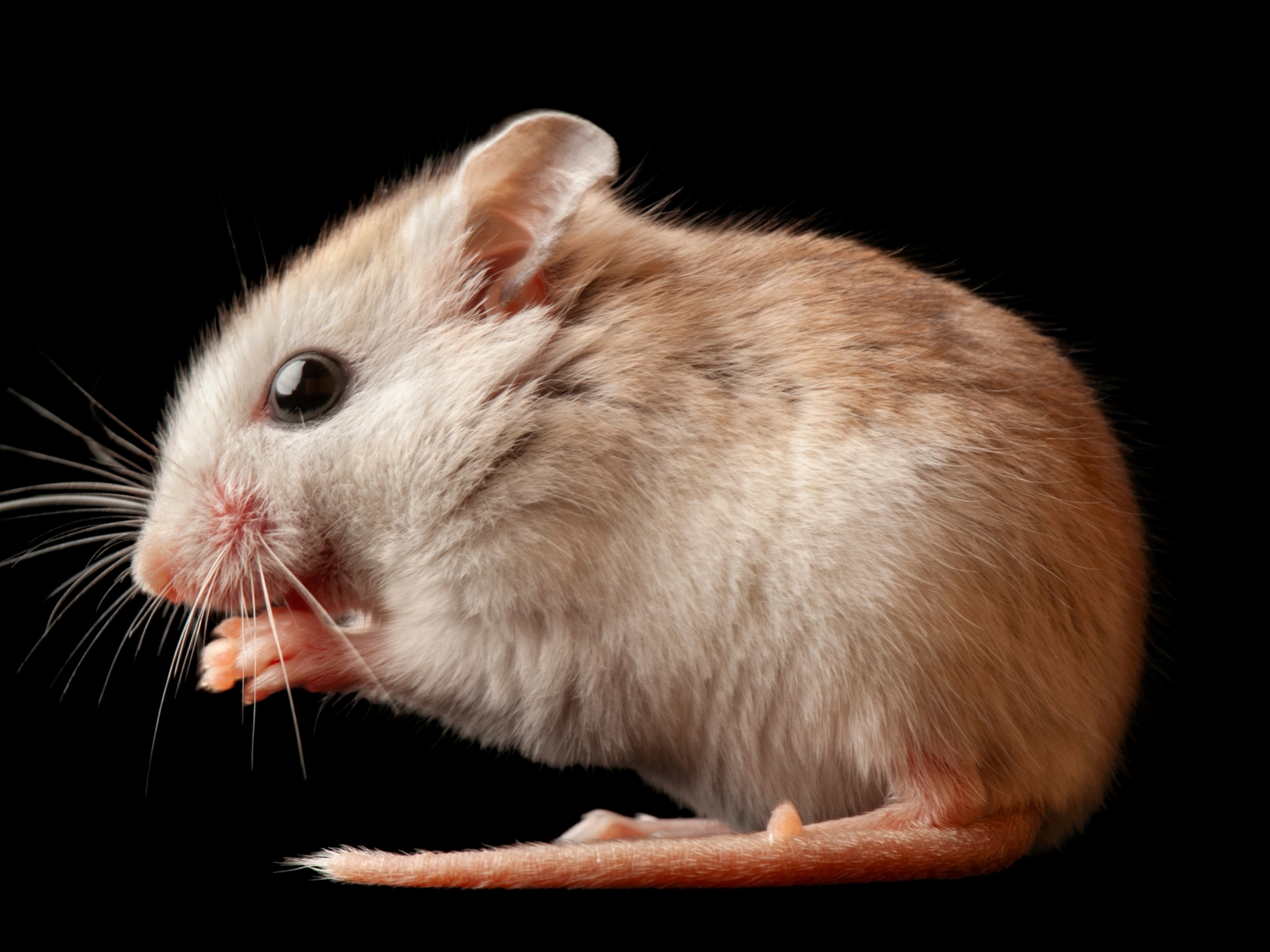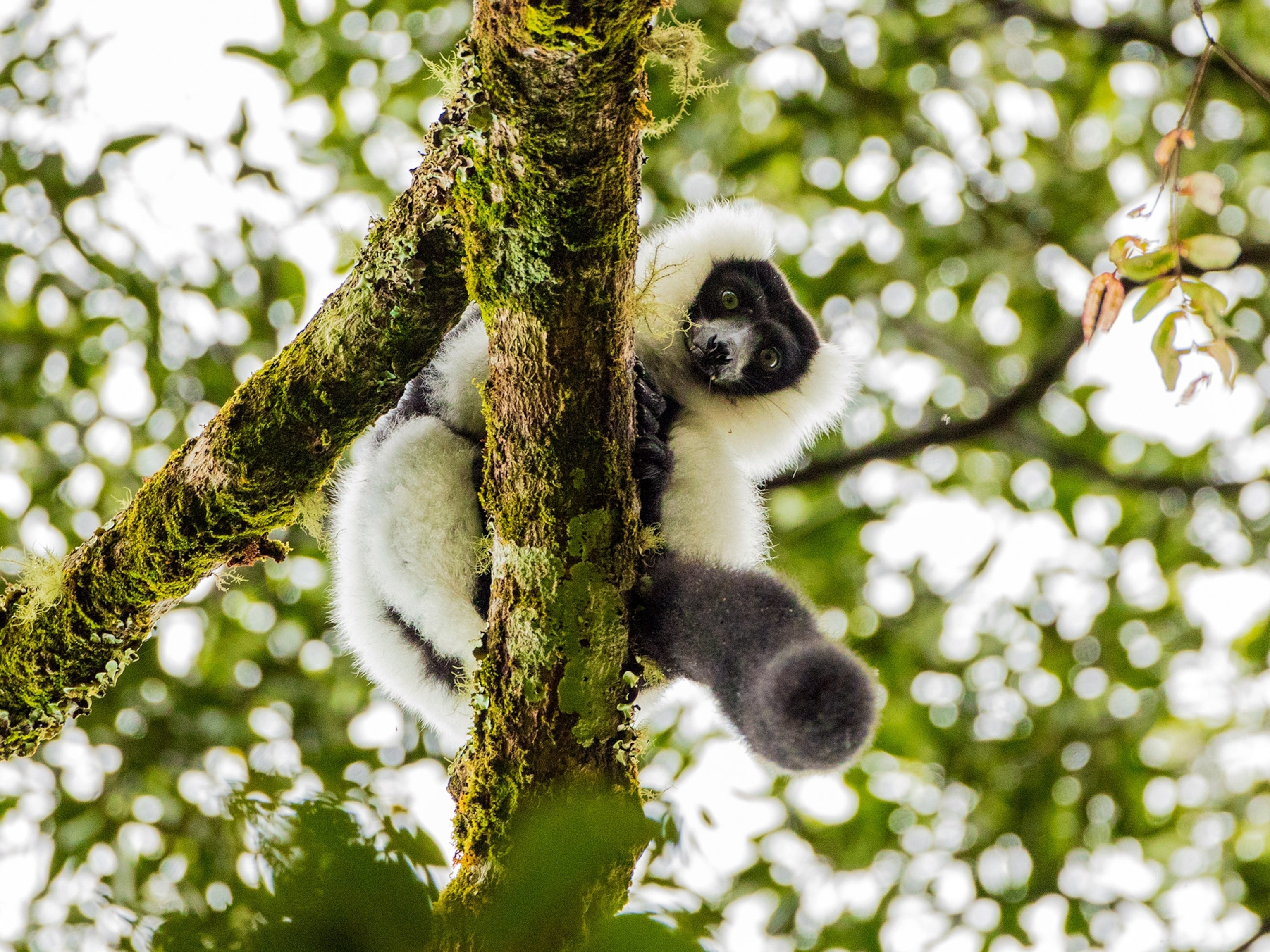Once Upon a Dragon
Earth’s most monstrous lizard faces an uncertain future.
Here’s what it takes to catch a dragon.
Slaughter a goat. Cut it up. Enlist a few strong friends to hoist three ten-foot-long steel traps, grab bags of goat meat, and trek a few miles up and down knee-punishing hills. Ignore the 90-plus-degree heat that wraps you up and steams you like a dumpling. Set up the first trap with hunks of flesh and hang a few meat bags in trees to “scent” the air. Hike another couple of miles. Lay another trap. Cover three or four more miles, repeat. Return to camp; fill a bucket with cold water and dump it over your head. Sleep. Revisit each trap in the morning and afternoon for the next two days. They’ll likely be empty, but if you’re lucky, you’ll draw near, and there it will be: the world’s biggest lizard, a grim-faced giant known as the Komodo dragon.
The man who devised this scheme is not your stereotypical dragon hunter. Claudio Ciofi, in his late 40s, a biologist and lecturer at the University of Florence, is mellow, slight of build, with kindly eyes. Tidy. He’s the kind of guy who neatly folds his filthy field clothes when he packs to go home. He arrived in Indonesia in 1994 to complete a Ph.D. on dragon genetics. Then he saw the living relics up close. He was entranced. And other scientists weren’t really paying attention to them. “I expected to find an organization studying dragons,” he recalls. “They are as charismatic and interesting as tigers and orangutans. But there was no one. Komodo dragons were all alone.”
So Ciofi expanded his research. He sought to understand every aspect of a dragon’s life. With quiet persistence and top-notch Indonesian and Australian collaborators, he has given us much of our knowledge of the dragons and is working to improve their chances of surviving their 21st-century troubles. Even though they are dragons and can grow as long as 9.9 feet and weigh nearly 200 pounds, they are still vulnerable to the modern problems that afflict so many animals, from habitat loss to climate change.
Of course monitor lizards, as the dragon’s family of animals is known, have survived many cycles of change. This particular species split off maybe five million years ago, but its genus goes back some 40 million, and its dinosaur ancestor lived 200 million years ago.
Varanus komodoensis has the lizard lifestyle down—basking in the sun, hunting and scavenging, laying and guarding eggs with no intention of being a parent after they hatch. Dragons put in a good 30 to 50 years, most of the time solo. Meanwhile their window on the world is mighty small: They’re found on just a few islands in Southeast Asia, all within the Indonesian archipelago. Jutting abruptly from the sea, these rugged volcanic lands have palm savannas and grasslands. Up higher are rings of forest. But much of the year the dragons’ habitat is dragon brown, with monsoon season a brief green reprieve.
The earliest record of this extraordinary lizard is likely the three words “Here be dragons” emblazoned on ancient maps of the region. And surely the first humans who saw the animals would have added: Beware! An avid hunter, the Komodo dragon can hit 12 miles an hour in short bursts. The reptiles ambush their prey, ripping open the softest flesh, typically the belly, or maiming a leg. As a backup, dragons do, in a way, breathe fire. Their mouths drip with venomous saliva that keeps blood from clotting—so bite victims bleed out quickly. A wounded victim that gets away is likely to pick up pathogens from watering holes, resulting in infection. Either way, death is almost certain. And dragons can be very patient.
The lizards also scavenge—they’re opportunists, always on the lookout for food, alive or dead. Scavenging takes less energy than hunting, and the dragons can detect the scent of a rotting carcass from miles away. Little is wasted: The big lizards aren’t picky about which body parts they eat.
Despite the dragon’s somewhat off-putting habits, islanders do not necessarily respond with fear and disgust. An Indonesian folk story tells of a prince about to slay a dragon. His mother, the Dragon Princess, appears and cries, “Do not kill this animal. She is your sister Orah. I bore you together. Consider her your equal, because you are sebai—twins.”
Modern times have not entirely quashed this belief. In Komodo village I climb a crooked wooden ladder to the house on stilts of an elder named Caco, who guesses his age to be 85 years. My guide says this slight, bespectacled man is a dragon guru; the elder doesn’t refute the title. I ask him how villagers feel about dragons and the danger they pose. “People here consider this animal our ancestor,” he says. “It is sacred.”
In years past when islanders would kill a deer, he said, they’d leave half the meat as an offering to their scaly relative.
Then things changed. Although no one has solid figures, the dragon population appears to have declined over the past 50 years. The government offered legal protection, responding to pressure from conservationists and also realizing the economic value of dragon-related tourism. In 1980 much of the dragon’s habitat was turned into Komodo National Park (KNP), which encompasses all of Komodo, Rinca, and other smaller islands. Later three nature reserves were added, two of them on Flores Island.
Dragons are safeguarded from any human assault within KNP. What’s more, dragon prey is also off-limits: Killing deer is forbidden. And thus villagers are no longer able to offer meat.
That, some say, has made the dragons more than a bit peeved.
Attacks aren’t common, but recently a few have made the news. Last year a 6.5-foot-long monitor wandered into an open office in KNP and bit two rangers, each on the left leg. The men were flown to Bali for treatment to prevent infection. Both recovered. In another incident an 83-year-old woman fought off a six-plus-footer with a homemade broom and well-placed kicks. The dragon bit her hand, which needed 35 stitches.
Other incidents have ended tragically. In 2007 a dragon attacked a village boy named Mansur, who had taken a break from a soccer game to relieve himself behind some trees. He died of blood loss.
Today villagers who see a dragon coming close or putting the move on livestock will typically yell and throw rocks. “People who live with dragons are used to living with dragons,” Ciofi says. “You might shoo a squirrel away that comes to steal your lunch. They treat dragons like that.”
As for dragons that attack, the government has moved offenders away from villages, but the animals usually return.
Not all encounters end badly. The first man to really sit with dragons for a spell was Walter Auffenberg, a curator at the Florida State Museum. In 1969 and ’70 he and his family camped on Komodo Island for 13 months, recording detailed observations of the animals’ every move. He authored an insightful book, The Behavioral Ecology of the Komodo Monitor.
Auffenberg’s family was surprisingly relaxed about venturing afar to rough it among deadly animals. Packing up powdered milk and chocolate, his wife, Eleanor, told a local newspaper that her best friend thought she was crazy. “Crazy, maybe,” Eleanor replied. “Worried, no.” Life in a big city would be more terrifying, she said.
During the fieldwork Auffenberg wrote of curious dragons wandering into his blind. One tongue flicked his tape recorder, knife, and feet. To encourage the lizard to leave, he flicked back, tapping it on the head with his pencil. Apparently it worked. Another “stretched out in the shade … with his front leg draped over mine as he lay there half asleep.” Auffenberg was able to prod the animal to leave without incident.
Back in the ’70s Auffenberg wasn’t that worried about the survival of the Komodo monitors. Today scientists ask: Can these dragons carry on?
Dragon salvation relies heavily on the mundane issue of land management. On Flores, despite the nature reserves, locals set fires to clear land for gardens and pastures, breaking dragon habitat into small fragments. Also, some people still hunt the deer and pigs that dragons like, as do feral dogs. And scientists suspect the dogs may chase—and even kill—young dragons, which spend their first year in the treetops but then come down to earth.
So the Flores dragons are boxed in: by villages, farmland, rice fields, the sea, and the dogs. That means less living space and a decline in prey. And ultimately fewer dragons.
If a changing climate affects the landscape, the dragons aren’t well equipped to cope. Ciofi and ecologist Tim Jessop of the University of Melbourne, who’s been researching dragons for the past decade, explain that with fewer than 5,000 animals scattered over a small number of islands, there’s reduced genetic diversity, which limits their ability to adapt. The dragons could improve their genetic pool by swimming from island to island to mate. But while they’re capable swimmers, strong currents and differences between island habitats discourage them. Besides, they’re homebodies.
To learn more about dragons, Ciofi, Jessop, and their Indonesian colleagues have caught and tagged about a thousand and have DNA samples from 800. Their efforts have told them a lot about numbers, male-female ratios, survival rates, and breeding success—and how inbred the populations are. The genetic differences they find aren’t the kinds of things that show up on the outside—bigger teeth or fatter tails. They’re the seemingly innocent codes within that dictate who survives and who doesn’t. Then comes the match game: figuring out how to shift animals from one group to another, making sure the newcomers aren’t related to each other.
A more extreme approach, if numbers were to plummet, would be to ship in zoo animals to bolster the gene pool. In Indonesia Komodo dragons have been breeding in captivity since 1965. In 1992 the first baby dragon was born outside the homeland, at the National Zoo in Washington, D.C. Since then, breeding efforts have gone like gangbusters. Today about 400 dragons live in zoos worldwide.
But playing God is controversial, Jessop notes: “We could be breaking the evolutionary integrity—messing with the natural path the animals are on. Some people are reluctant to do that.” Besides, programs that relocate local animals only “work about half the time.” Nor is the transition from zoo life to the wild an easy one. And there is no guarantee that putting adult dragons together will yield offspring—or that the dragons can survive long term in such unevenly protected habitat.
Ciofi and his colleagues are respectfully pressing Indonesian officials and mustering support for dragon preservation. They speak to islanders on Flores of the danger to dragons from habitat loss and the poaching of prey. They hope to better monitor protected areas and train rangers in dragon biology so they can offer information to scientists about how the animals are faring.
Meanwhile tourists who come to see dragons—other than the lazy ones hanging around the ranger station—must be patient. The wilder animals don’t like to be found. During my two weeks on the islands I mostly chase after biologists on futile dragon hunts. Our hiking pace is set by young, fit Indonesians Deni Purwandana and Achmad Ariefiandy, who lead the Komodo Survival Program, established in 2007. Then comes Jessop, a giant of an Aussie whose single stride requires three of mine. A few nature reserve staffers and a couple of villagers, untroubled by heat and hills, round out the team.
When Ciofi and I arrive on Flores, the team’s 26 traps have caught just four dragons (and many more dogs), down from 14 the same time the year before. But this may not indicate a reduced population. Cameras at the sites show the dragons sniffing traps, then deciding not to walk inside.
The elder I met, Caco, had told me villagers used to offer tree seeds, a local tree leaf, an egg, and the tobacco from one cigarette to lure dragons out of the hills. He presented me with seeds and a leaf. I am tempted to use them.
Then on my second to last day, the stars align. There are three traps to check. The first round—nothing. On the next circuit we see pebbly skin through the gaps of trap number three. It’s just a little dragon, less than four feet nose to tail tip, perhaps three years old. Subtly pretty (if you keep an open mind), it has dark gray, yellow, and orange body scales and faded dark bands down the tail. I kneel for a better look through a hole in the metal; it peers back with one yellow-ringed eye. Then the dragon catchers remove it with hook and lasso, tape its mouth closed (for our protection), and gently but firmly tie its legs and arms to its body to keep it still.
Next comes a flurry of activity. The team quickly measures the captive, weighs it in a sling, and uses a microchip reader to search (in vain) for a tag beneath the skin that would represent a previous capture. Blood is drawn from the tail for genetic analysis; photos are snapped from every angle. The trappers who seek to preserve this ancient species speak matter-of-factly of the encounter: “It’s our job.” In less than 20 minutes off comes the mouth tape, and the animal is set free. It takes off like a shot into the woods, flinging dirt and rocks with madly scraping claws—the no-nonsense retreat of a real-life dragon.
